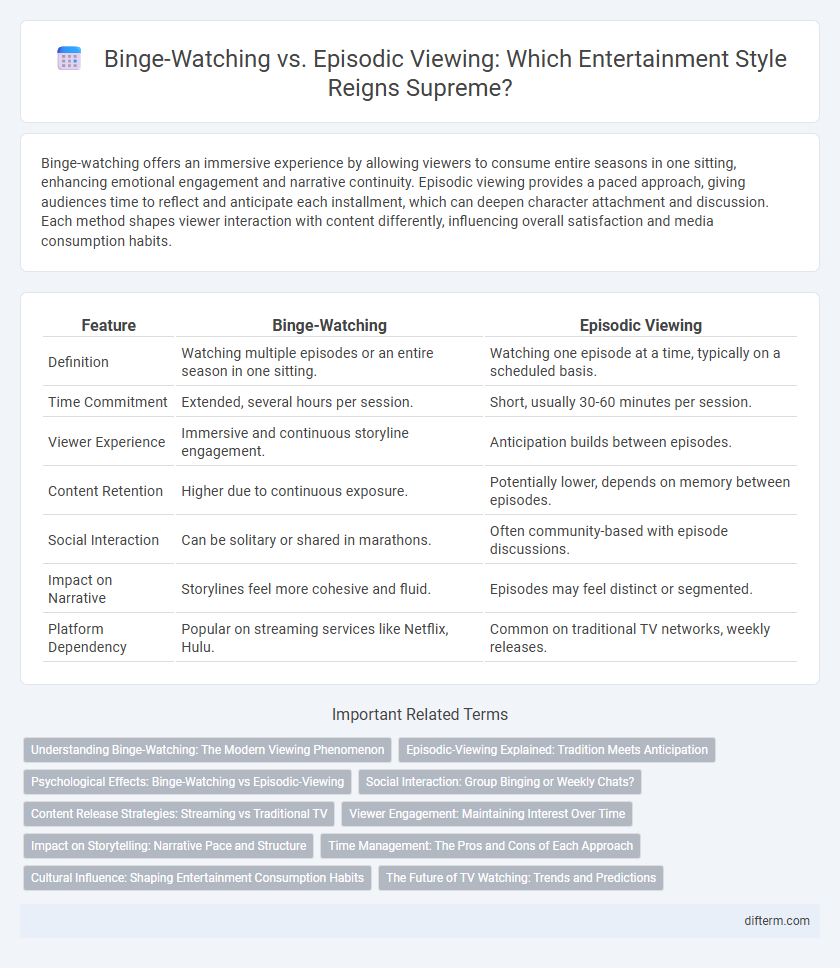Binge-watching offers an immersive experience by allowing viewers to consume entire seasons in one sitting, enhancing emotional engagement and narrative continuity. Episodic viewing provides a paced approach, giving audiences time to reflect and anticipate each installment, which can deepen character attachment and discussion. Each method shapes viewer interaction with content differently, influencing overall satisfaction and media consumption habits.
Table of Comparison
| Feature | Binge-Watching | Episodic Viewing |
|---|---|---|
| Definition | Watching multiple episodes or an entire season in one sitting. | Watching one episode at a time, typically on a scheduled basis. |
| Time Commitment | Extended, several hours per session. | Short, usually 30-60 minutes per session. |
| Viewer Experience | Immersive and continuous storyline engagement. | Anticipation builds between episodes. |
| Content Retention | Higher due to continuous exposure. | Potentially lower, depends on memory between episodes. |
| Social Interaction | Can be solitary or shared in marathons. | Often community-based with episode discussions. |
| Impact on Narrative | Storylines feel more cohesive and fluid. | Episodes may feel distinct or segmented. |
| Platform Dependency | Popular on streaming services like Netflix, Hulu. | Common on traditional TV networks, weekly releases. |
Understanding Binge-Watching: The Modern Viewing Phenomenon
Binge-watching, characterized by consuming multiple episodes of a series in one sitting, has revolutionized entertainment consumption by leveraging streaming platforms that provide instant access to entire seasons. This behavior engages viewers through continuous narrative immersion, fostering heightened emotional investment and sustained suspense. The phenomenon reflects broader shifts in media consumption patterns driven by on-demand accessibility and personalized viewing experiences.
Episodic-Viewing Explained: Tradition Meets Anticipation
Episodic viewing preserves traditional storytelling by releasing content one episode at a time, fostering anticipation and deeper audience engagement over weeks or months. This method promotes discussion and speculation between episodes, enhancing community interaction and emotional investment in characters and plotlines. Networks benefit from episodic schedules through sustained viewership and increased advertising opportunities tied to each episode's release.
Psychological Effects: Binge-Watching vs Episodic-Viewing
Binge-watching often leads to increased dopamine release, creating a cycle of instant gratification and heightened emotional intensity, which can result in viewer fatigue and impaired sleep patterns. Episodic-viewing encourages anticipation and reflection between episodes, supporting better memory retention and reduced cognitive overload. Psychological studies indicate that episodic consumption fosters deeper narrative processing and emotional regulation, contrasting with the overstimulation commonly linked to binge-watching.
Social Interaction: Group Binging or Weekly Chats?
Binge-watching fuels shared excitement through marathon viewing parties, enhancing immediate social interaction and collective discussion of plot twists. Episodic-viewing encourages ongoing weekly chats, allowing viewers time to analyze episodes and build anticipation together over time. Both viewing habits foster community engagement but differ in pacing and depth of social interaction.
Content Release Strategies: Streaming vs Traditional TV
Streaming platforms frequently employ binge-watching content release strategies by releasing an entire season simultaneously, encouraging prolonged viewer engagement. Traditional TV relies on episodic-viewing with scheduled weekly releases, promoting anticipation and consistent audience retention over time. These contrasting content delivery methods influence viewer habits, advertising models, and subscription dynamics in the entertainment industry.
Viewer Engagement: Maintaining Interest Over Time
Binge-watching intensifies viewer engagement by providing continuous, immersive storytelling that reduces waiting time and builds emotional investment through rapid plot development. Episodic viewing allows audiences to savor plotlines and character arcs, fostering anticipation and deeper reflection between episodes, which can sustain interest over extended periods. Balancing pacing and content delivery in both formats influences how effectively viewers remain captivated throughout a series.
Impact on Storytelling: Narrative Pace and Structure
Binge-watching transforms narrative pace by encouraging faster storytelling rhythms and tighter episode sequencing to maintain viewer engagement across multiple episodes. Episodic viewing preserves traditional narrative structures with distinct act breaks and cliffhangers designed to build suspense over time. This shift impacts character development and plot complexity, as binge formats favor continuous momentum while episodic formats foster reflection and anticipation between installments.
Time Management: The Pros and Cons of Each Approach
Binge-watching enables viewers to complete entire series quickly, offering immediate gratification but often leading to time mismanagement and fatigue. Episodic-viewing spreads screen time over days or weeks, promoting better daily productivity and anticipation but potentially causing slower narrative engagement. Choosing between these approaches impacts how viewers balance entertainment with other time commitments, influencing overall lifestyle efficiency.
Cultural Influence: Shaping Entertainment Consumption Habits
Binge-watching, driven by streaming platforms like Netflix, has transformed cultural habits by promoting immersive, marathon viewing sessions that cater to instant gratification. Episodic viewing retains cultural significance through traditional TV networks and social rituals, fostering communal anticipation and discussion around scheduled broadcasts. The cultural influence shapes entertainment consumption habits by balancing the desire for immediate content access with the nostalgic value of shared, time-bound experiences.
The Future of TV Watching: Trends and Predictions
Binge-watching continues to dominate with streaming services releasing entire seasons at once, catering to viewers' desire for instant gratification and immersive storytelling. Episodic-viewing remains relevant through platforms leveraging weekly releases to build anticipation and foster community engagement via social media discussions. Future trends indicate a hybrid model, where AI-driven personalized schedules optimize viewer retention by blending binge sessions with episodic pacing tailored to individual preferences.
Binge-watching vs Episodic-viewing Infographic

 difterm.com
difterm.com